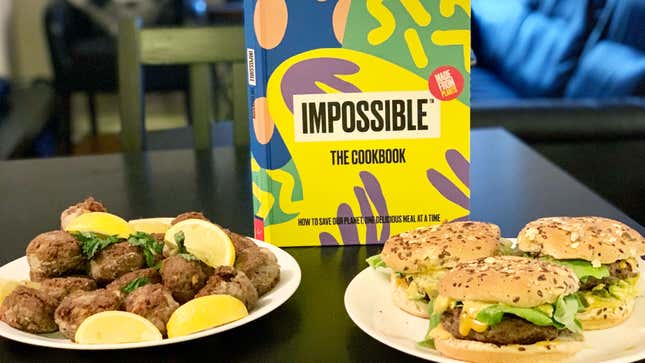
Last night, I logged into a Zoom cooking class, as one does during a global pandemic where indoor, in-person activities are frowned upon. This class was a little fancy: It was led by Traci Des Jardins, a real bonafide chef, and the recipes were from Impossible Foods’ newly launched Impossible Cookbook, featuring possibly the most well-known plant-based meat, the Impossible Burger.
It’s interesting timing. Impossible Burger 2.0 isn’t exactly new, after all. We got a chance to taste-test it at CES 2019, and some of my Gizmodo colleagues previously got a chance to whip up some burgers and tacos once the fake meat was finally approved for sale in grocery stores. A few months ago, my colleague and grill master Sam Rutherford cooked up several plant burgers in a blind taste test, which I was happy to assist with (i.e. shove food down my gullet without doing any work). Heck, at CES 2020, I even got to nom on Impossible Foods’ take on ground pork. So, it was a bit curious that now was the ideal time for a cookbook to drop.
According to an Impossible spokesperson, this cookbook is dropping now because, after a long, slow process, this is the year that Impossible Foods is pushing for its plant beef to be readily available nationwide—not just in Southern California or certain East Coast grocery chains. And once it’s widely accessible, people will be clamoring for recipe ideas, hence the cookbook.
There’s some truth to that. I’ve hunted for Impossible Burger 2.0 at several grocery chains in New York City and come up short. The only one I know that reliably carries it is Wegmans in Brooklyn, and that’s a schlep for me. But even though I know you can technically substitute it for any ground beef recipe, the few times I’ve bought it for myself, the bricks inevitably sit in my freezer for weeks. That’s because 1) I’m not sure what to make besides burgers, and 2) surely there are some differences that home cooks haven’t accounted for.

And yes, there are differences. For starters, Des Jardins noted that Impossible meat does not shrink in the pan and cooks slightly faster than regular beef. In burgers, it won’t “bleed” if you leave it sitting for a bit, even though the heme molecule in the patties do give a medium-rare burger a “bloody” look. That’s because it doesn’t release as much fat or moisture during the cooking process. The cookbook actually says it absorbs more liquid and that you might have to add up to 25% more in certain recipes. It also doesn’t necessarily need a binding agent when forming meatballs, patties, or meatloaf. I’m sure these things hold meaning to people who are competent cooks and don’t make the same five recipes week in and week out.
This sort of flew over my head while I tried to keep up with Des Jardins, frying keftedes (Greek meatballs) and grilling three Impossible Jardiniére burgers, Des Jardins’s own recipe from when the Impossible burger first made its West Coast debut. Mainly, I was thinking about how slimy Impossible beef is and whether regular beef is equally slimy. (I don’t think it is.) I was also desperately trying not to burn my tiny kitchen down or die under an avalanche of dirty dishes and pans. Somehow, amidst all the chaos (pro chefs cook real fast), I forgot I wasn’t handling real meat.
Flipping through the cookbook, the recipes are pretty wide-ranging and incorporate several cuisines from around the world. There’s chile rellenos, mapo tofu, Ethiopian spiced meat with hummus and toasted cashews, and even bulgogi—which I’m going to have to try because the Korean in me is extremely skeptical. The bulgogi my family makes is not made with ground beef.

Still, there are some limitations. Most of the recipes stick to fillings, iterations of meatballs, stir fry, and skewers. All this makes sense, as we’ve known for a long while that Impossible meat can’t replicate a steak or more solid cuts of meat. That said, the cookbook does an admirable job of making you consider Impossible meat for things other than burgers.
At the end of the class, my keftedes, though somewhat misshapen, were tasty—maybe a little on the dry side, but close enough to a real meatball that I wouldn’t have questioned it. The burger was also pretty good—I’m sure true beef lovers would be able to tell me the minute differences, but I am not a big beef person so it was good enough for me. As a plus, I noticed that an Impossible burger doesn’t leave me quite as comatose afterward as a 100% beef burger. And while I was skeptical at first about why I’d ever need a cookbook to whip up something with Impossible meat, I’ll admit I never considered adapting more traditional recipes. Now, I’m going to try making this plant-based bulgogi and see whether my mother disowns me.